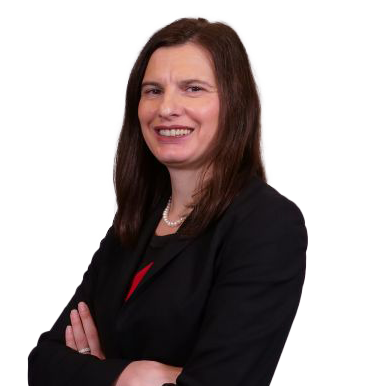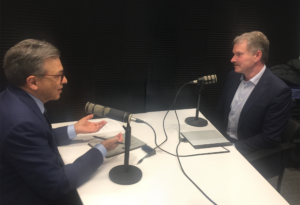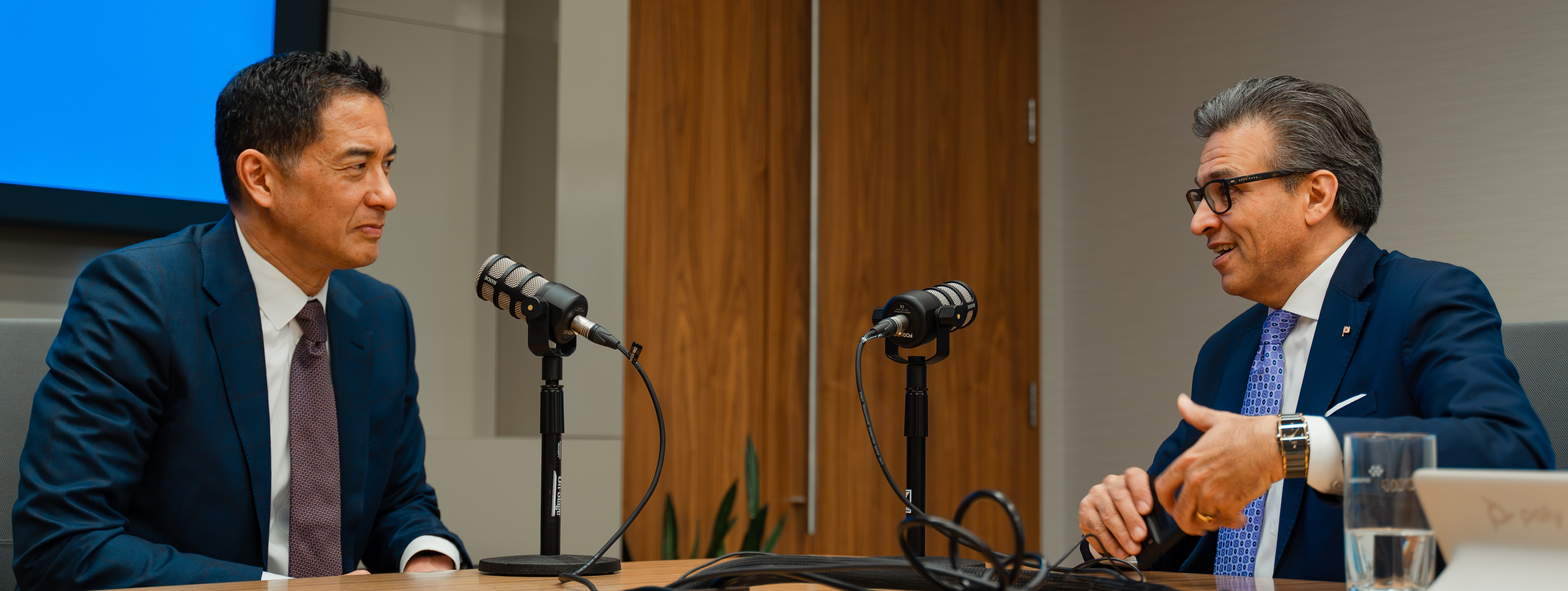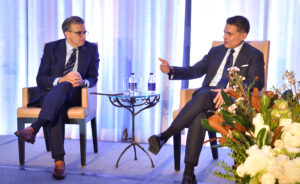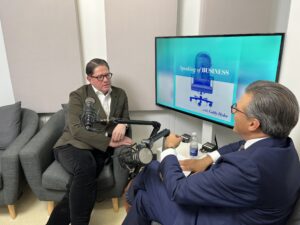How does an employer maintain a sense of community and office culture when many people are working from home?
For Sonja Volpe, part of the answer lies in bringing staff together through volunteerism. “Volunteering is taking on an even more important role in the future hybrid work environment,” says the CEO of BNP Paribas in Canada. “It provides us the opportunity to engage with each other, to build out the internal network and strengthen the team dynamic while, of course, helping those in need.”
In conversation with Goldy Hyder on the Speaking of Business podcast, Volpe outlines how BNP Paribas – an international bank operating in 65 countries – is planning for what it calls “organized flexibility”. In practical terms, that means bringing employees back to the office 50 per cent of the time as COVID-19 restrictions ease.
“Even though we’ve been extremely efficient and productive in a remote environment during the pandemic, that’s not the way of the future. We need to spend time together and hence time at the office is important,” she says.
On the podcast, Volpe also explains how BNP Paribas is addressing climate change through sustainable financing … and why the bank’s Montreal office includes an urban farm!
Sonja Volpe:
There’s definitely a fundamental transformation underway. Even though we’ve been extremely efficient and productive in an almost 100% remote environment during the pandemic, that’s not the way of the future. We need to spend time together to do all these things and hence, time at the office is important. I think what comes into the spotlight is what we do and how we spend that time together at the office.
Goldy Hyder:
Welcome to Speaking of Business, conversations with Canadian innovators, entrepreneurs and business leaders. I’m Goldy Hyder, president and CEO of the Business Council of Canada.
Last fall, a group of bank employees in Montreal swapped their business attire for T-shirts. They grabbed some shovels and planted trees along the city’s waterfront. Not a typical day at the office, but let’s face it. The definition of a typical workday has changed a lot during the COVID-19 pandemic. Sonja Volpe was part of the tree planting crew. The CEO of BNP Paribas in Canada oversees more than 1,200 employees who work for the international bank. Like many business leaders, Sonja has had to adapt and evolve to new challenges over the past few years. What has she learned along the way? Let’s find out.
Welcome, Sonja. How are you?
Sonja Volpe:
Good. Thanks Goldy for having me.
Goldy Hyder:
Well, it’s great to have you here. Now, we got to… We got to start with what I said right off the top. Tell us about the whole donning the T-shirts and grabbing shovels to plant some trees along the waterfront. What was that all about?
Sonja Volpe:
2021 was a very special year for us. We celebrated 60 years of continuous and growing presence in Canada and as you mentioned, we’re now over 1,200 employees strong between our two offices in Montreal and Toronto. So, when we started to plan how we want to celebrate this milestone, given that it was a pandemic year, we identified three key areas of focus. Of course, our employees, our clients, and then we also said, “Look, we want to do events that will support our key partners so that we can also make an impact on our local communities.”
Soverdi, who worked with us on this tree planting event, has been a partner of ours for several years now and with BNP Paribas’ focus on sustainability and local communities, tree planting quickly captured our attention. So, what we wanted to do is plant one tree for each employee and that’s how we got to the goal of planting 1,200 trees at the time, which actually… Two groups of employees, including myself, planted 150 over two half-days back in the fall. So, definitely, as you said, not your typical day in the office, but it was a really big day for us and a great way to mark our milestone.
Goldy Hyder:
Well, it sounds like volunteerism is something that’s core to you and core to the company. And, why is that for you personally?
Sonja Volpe:
It absolutely is important. I think personally because I recognize that we have a responsibility to support those around us and give back. Organizationally, it’s been a core value of the firm globally and for us here in Canada for some time as well. I do think that volunteering is taking on an even more important role in the future hybrid work environment and it’s because it provides us opportunity to engage with each other, to build out the internal network and strengthen the team dynamic while of course helping those in need.
I actually think the hybrid work environment is going to be quite interesting and the role of volunteering in that environment is… As you can imagine, we’re really not going to have 100% of our staff at the office at all times. Our model actually is going to be 50/50, so half of the time spent at the office and half working remotely. So, we’re going to have to provide opportunities for employees to engage with each other but also on common areas of interest and I think here it’s where volunteering will play such a pivotal role.
We’ve contributed 1,200 volunteering hours last year despite both in Montreal and Toronto having been shut down for quite some time and there having been less opportunity to support such events. And, I’m thrilled to share with you that when we were recognized as the top 100 employer in Montreal, that actually our employees’ passion for giving back very much stood out.
Goldy Hyder:
That’s a great achievement. Congratulations. And, as you note, very much a team effort and a big part of your culture.
Many organizations, when I speak of culture, are thinking about how work itself is going to change and how that affects the things that were somewhat sacred to work. Right? Culture being number one. Collaboration, co-creation, teamwork. How do you see the changing nature of work and what are you going to do to make sure that the good things about the old model aren’t lost?
Sonja Volpe:
Yeah. It’s a very good question, Goldy. I think that’s going to keep us all busy for some time. There’s definitely a fundamental transformation underway. Maybe picking up on your comment there around the importance of collaboration, teamwork, culture, sense of belonging, I couldn’t agree more with you and actually it’s for these reasons that we as an organization knew early on that even though we’ve been extremely efficient and productive in an almost 100% remote environment during the pandemic, that’s not the way of the future. We need to spend time together to do all these things and hence, time at the office is important. I think what comes into the spotlight is what we do and how we spend that time together at the office.
And, I think that’s where a lot of the learning will come from near term. We’re actually about to embark on that learning ourselves as we’re actually going to kick off our new ways of working that we’re calling smart working where we’ve actually asked all our staff to come to the office starting the latter part of March for one day a week and we’re going to then gradually increase that to two days a week and then to that sort of 50% time at the office that I alluded to earlier.
And here, it’s really around then how we ensure that we remain inclusive. Right? That we’re inclusive in those interactions and the collaboration regardless of the place of work at any given time. We definitely have the technology that can enable that. I think the intention here is going to really be around human behavior and that we don’t let any new biases sort of creep in based on particular individual might be working on a particular day.
So, I think how we integrate those that just happen to be off site on a day when they are still collaborating with others in the office, how we make that seamless, how we provide ongoing opportunity for clients to engage also with our employees, and then of course employees with each other, is going to be what’s going to make the difference. Here, I would say our employee resource groups are going to play a very important role. They have played a pivotal role during the pandemic by hosting pretty much everything virtually for almost the past two years. And, now as we kind of transition to this hybrid environment, they’re going to also need to be in tune with that employee experience, knowing that not everyone is at the office at the same time.
So, I have no doubt that we’ll be able to incorporate all the good things of that pre-pandemic environment into the work experience. But, it’s going to take some deliberate attention because I have no doubt that there are going to be areas that are going to need further attention as well.
Goldy Hyder:
Yeah. I think you’re right about that and you know from our own membership, everybody is kind of struggling with this.
Sonja Volpe:
Yeah.
Goldy Hyder:
And, at a meeting we had late last year, you recall, we’d heard from others looking into North America and saying, “You know, some of this really appears to be a North American phenomenon, that in Asia and Europe, it’s less so about hybrid work.” And, they said it’s partly because of the sizes of houses we have here, the distances to travel here to go to work, the relatively poor infrastructure. We don’t have a lot of high speed rail in this country or any of that kind of thing. So, you know, another consideration social supports, et cetera. So, it’d be interesting to see whether this is a competitive disadvantage for North America if the rest of the world is kind of going back to the old model.
Do you think that businesses may regret having jumped the gun to go to the hybrid model so quickly? Because, did we ever look at what people really wanted? Maybe all they wanted was flexibility.
Sonja Volpe:
I think time will tell. There’s no doubt that people want flexibility and in a way, the hybrid model does provide that flexibility. It’s really how… In a way, it’s going to need to be organized flexibility. Right? Because, if it’s too individually flexible, it may ultimately not help achieve organizational goals. So, it’s really sort of finding that way where the model works for both the employee as well as the employer, and ultimately I think everybody’s going to be guided by what are the objectives for the year, whether from the business perspective or across other objectives that we have in the year with regards to our employees and how we develop them and provide them opportunities.
I mean, it is a big experiment in a way. I think given that we’ve spent close to two years in a mostly predominantly remote environment, I think it’s natural to sort of start with a gradual comeback and looking at whether we can make the two worlds work, i.e., remote and at the office. And, I think it’ll be interesting to see whether we can because obviously if we cannot, we know what it could go back to, which is to more time at the office. Right? But, look, I’m optimistic that with the right level of attention from the management team in, broadly speaking, supporting everyone so that it’s an inclusive transition, that we’ll be able to get there.
Goldy Hyder:
I guess time will tell. Won’t it?
Sonja Volpe:
That’s right.
Goldy Hyder:
I love the organized flexibility. I haven’t heard that before. I’m going to use that. Now, you mentioned… And, I’m going to stick with the return to work theme because I just think it’s fascinating, especially because you’ve got a bit of a global lens on this, right? With your colleagues around the world. You know, when you look at the changing nature of work, it’s not just the physical workplace that’s also changed. Right? It’s the nature of the work that’s changing and we’re talking more about sort of the re-skilling agenda, if you will, and lifelong learning.
Sonja Volpe:
Mm-hmm (affirmative)-
Goldy Hyder:
You know, you kind of look back and you think about the model that we’ve all grown up in, which is you kind of go to school til you’re like 25 and then you’re told whatever you’ve learned should last you til you’re 65. That sure seems to be out the door today. What are you doing to help your employee base prepare for the future of the way work is going to change for them?
Sonja Volpe:
It’s another very good question, Goldy, and actually what we also see is… I mean, in addition to the need for sort of ongoing up-skilling and training, we’re actually seeing our employees wanting to do that. Okay? So, when we look at our early career talent, they are looking to change roles and progress much quicker than what talent looked to do even just 10 years ago, and this requires an ongoing attention on the talent, the talent development and their learning.
So, we have a program that we call Internal Mobility and that’s really a program through which we enable movement of the talent that’s at the firm that has expressed an interest to look for new opportunities. And, in recent years, we’ve looked to have talent in the role for a couple of years before they move on and we’ve actually needed to shorten that timeframe. Okay? Because, our experience is, look, unless we facilitate our talent’s learning and mobility, they’re going to leave and then we lose everything that we’ve trained them on and everything that they have contributed to do so far, and we don’t want to do that.
So, approximately… Our number in Canada is roughly 30% of our open positions are actually filled by internal candidates and as part of our next five year plan at the group level, we’re actually looking to have it almost at 50/50. You know, that half of the roles are filled with internal candidates and the other half by external candidates. So, how do we enable that learning? You’re absolutely right. We have an internal focus, something that’s called the Canada Academy, so this is actually when we have subject matter experts that train other employees in particular areas of expertise. There’s a broad range of courses offered here from kind of soft skills and managerial skills to being a mentor and more technical IT and finance trainings.
But, we know that we cannot only rely on internal trainers. We need to supplement that through external programs and here we actually provide tuition subsidies to our staff to take courses externally as well as subsidies for professional accreditation. So, we know that it’s a balance between what we put on the offer internally and the Canada Academy offering has grown very much over the years that we’ve introduced it here in Canada and we continue to also tap into some external resources that are enabled for us by our regional office in the U.S. So, it really is a combination of sources through which we tap into the content, but the fundamental sort of rationale and driver is really this demand from our talent around mobility and moving within the firm, whether in Canada or even more broadly.
Goldy Hyder:
You and I are speaking here with about five days to go here at the end of February and by the time people are listening to this, hopefully we’ve really turned a corner on the pandemic. But, an area where we’ve not turned the corner… In fact, we have a lot of work to do, is climate change.
Sonja Volpe:
Mm-hmm (affirmative)-
Goldy Hyder:
And, I’m wondering about BNP itself. It’s been a very big proponent of sustainable finance. What does that mean in a Canadian context? How are you approaching your role as a financial institution and what does that mean in the climate change journey that we’re all on?
Sonja Volpe:
I mean, look, climate change will profoundly alter our way of life and the structure of the economy. It does present systematic risks to financial security, but it also presents the financial industry an enormous opportunity to enable positive transformation, particularly by using innovative tools to help companies tackle global issues.
So, the way we looked at it is we brought our sustainable finance expertise to our Canadian clients by providing them advice and strong execution on sustainable finance transactions, and here I’m referring to sustainability-linked loans, green bonds, sustainable bonds in particular. And, we’ve also engaged with our client leadership teams as they develop their own sustainability strategies. I’ve seen significant progress made at Canadian institutional and corporate clients in this regard over the past years and from my discussions with executives, Canadian companies recognize the value of investing in a sustainable future and many already taking proactive steps to invest in projects that will positively impact the environment and our communities.
There’s no doubt that it’s quite a lengthy road, I think, ahead of us overall, not just in Canada but I think from a global perspective. You know, this is quite transformational, but at the same time, we’ve all seen the speed of change only accelerate in recent years and it’s going to be really key to ensure that we in the financial services industry obviously look to support it through financial product innovation and really help our clients transition to and align with their sustainability strategies. So, I think it’s going to be a very interesting time ahead, Goldy.
Goldy Hyder:
So, clearly a big role for the private sector in supporting the energy transition.
Sonja Volpe:
Oh, absolutely. And, look, there’s no doubt that the private and the public sector have incredibly important roles to play here. We’ve publicly announced these transactions but we’ve done deals with Brookfield Renewables Partners, Northland Power, Teck, all of which include metrics supporting the energy transition. So, this is back to referring to sustainability-linked loans in particular. And, you know, it is really important for the private sector to continue to make further tangible improvements in order to move the needle on the energy transition and financial products, in a way, have served a very important purpose in bringing attention to the particular issue.
There are two recent announcements that we made at the bank that might be worth highlighting, Goldy. You know, one… In April of 2021, BNP along with other leading financial institutions became a founding signatory of the Net Zero Banking Alliance. So, the members of this alliance are committed to be a powerful force towards achieving a net zero economy and pushing for decarbonization strategies and also providing an internationally aligned framework for banks to support their effort.
Internally, more recently we announced the formation of the Low Carbon Transition Group. So, what this is is a dedicated part of the organization that will support our corporate and institutional clients around the world in accelerating their transition to a sustainable and low carbon economy. So, this group will engage with clients on their transition needs across the broad suite of BNP products with a particular focus on advisory debt inequity through our M&A energy resource infrastructure as well as equity capital markets platforms.
So, it’s these initiatives like the Net Zero Banking Alliance, the Low Carbon Transition Group, that will accelerate the decarbonization pathways and a key point of attention I think for everyone along that path to energy transition is really to not get complacent. 2050 sounds and feels far away, but given the work that’s ahead, it’s really not, so it’s going to require a lot of in between objectives and milestones in order really to ensure that we get there.
Goldy Hyder:
Let me end with a couple of questions, perhaps one that’s a little bit bigger and the other one I think you’re going to enjoy answering. We’ve been asking everybody on the podcast for this season a simple question that does require some thought. The question is, what is the one big idea that you think could help transform Canada?
Sonja Volpe:
Thanks for the question, Goldy. I don’t know if you’ll see it as big, but I see it definitely as tremendously important, and that’s actually the need for a very strong continued investment in our education system and in a way to ensure that no talent is left behind. We’ve all, I think, read headlines in recent years around how our youngsters are doing and then the math scoring and where we rank sort of globally in that regard and I think you put two years of a COVID environment that certainly was not a great learning environment at all but we had to do what we had to do. Right? And, it creates an even greater point of attention when it comes to the education system and the strength of it.
So, I really hope that there’s work underway to put some specific strategies in place to ensure that our young talent can compete at the global stage and that we bridge the gaps that we knew were somewhat building already but also the ones that have surfaced in the recent years, just given what we’ve been through.
I can actually expand this to even add to the specific thematic in terms of where a lot of learning and upskilling is going to be needed more broadly and that’s really around ESG in its broader sense because it’s very material and as we discussed earlier in terms of the role that the private sector will need to play, the role that the public sector needs to play, the role the financial services sector needs to play… We’ve had a number of areas of subject matter experts that have contributed to the discussions and the implementations and the initiatives so far. But, to really ultimately get to where we all want to get to, it’s going to require a much more broader investment in this specific thematic, I think all the way from our youngsters and up. Right?
And, I know that some universities are already putting the attention on this and formulating different programs to address this particular area of need, but I think it’s going to need to be much more broad based than that.
Goldy Hyder:
Well, it’s a wonderful answer because in some ways, it’s first principles, right? If you don’t get the foundation of education right, you’re going to reap the rewards that you sow and reap the rewards that you don’t sow. And so, I think in a time in which we have such the talent shortage that we do, investing in education, you can’t go wrong. So, thank you for that as well.
Let me ask as a final question to you really is, I have to ask about the urban farm that is operating at your Montreal office. What is that all about?
Sonja Volpe:
Yeah. You definitely don’t hear often urban barn and the bank in the same sentence and yes, we have one and it’s currently under deep snow. Look, when we moved into our new building in Montreal, 2001 Robert-Bourassa, we started right away discussions with the property management company in terms of how we could improve… There’s this large concrete area around the terrace of our fourth floor. It’s sort of a terrace roof. Okay? And, they came to us with the idea to turn it into an urban farm and partner with MicroHabitat, which really got our attention because of course it would improve our environmental footprint, increase biodiversity in a city center, support small but sustainable local food system by helping those in need as the crops are donated to Accueil Bonneau which supports people experiencing or who are at risk of homelessness.
So, last year was the first year and the harvest from the urban farm, which by the way spans 1,600 square feet of that roof… It produced 500 kilograms of locally grown organic fresh vegetables, which was definitely more than anticipated. It was also a great sight from the floor looking out at the terrace because it was all very green and lush, and then of course with some added color during harvest time. But, it was a really great initiative for all the partners involved. We’re looking to potentially expand it even further and it perfectly aligns with our commitment to contribute to the changing world for a better future.
So, we’re really happy with the results of it last year and we look forward to expanding it further.
Goldy Hyder:
Terrific. Well, look, this has been fun. Thank you so much for doing it. We appreciate having you sharing your perspectives with us.
Sonja Volpe:
No, thanks very much, Goldy. It was a pleasure to be with you today.
Goldy Hyder:
Sonja Volpe is the CEO and country manager of BNP Paribas. I hope you can join me again on March 24th when I speak with John Graham, president and CEO of Canada Pension Plan Investments. Here’s a preview.
John Graham:
We are here to deliver the best total return to our 20 million Canadian contributors and beneficiaries. And it’s not lost on anyone in this company that our investment portfolio is global, but our contributors and beneficiaries are all Canadian. And that’s really who we’re here to deliver the best return for. So we have one fund, we have one brand and we do have one culture.
Goldy Hyder:
If you’re enjoying our Speaking of Business podcast, please give us a review, and if you’re new to the podcast and would like to hear more conversations with innovators, leaders and entrepreneurs, why not subscribe? Search for Speaking of Business wherever you get your podcasts or go to our website at thebusinesscouncil.ca. Yeah, The Business Council dot C-A. Until next time, I’m Goldy Hyder. Thanks for joining us.






